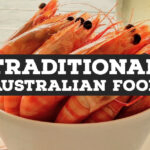This post may contain affiliate links.
Egyptian food is a unique blend of cultures and influences. Dishes date back to the ancient Egyptian era, while other favourite foods have origins in India, Africa, the Middle East or even Europe. Egypt sits between two continents – part North African and part Asian – making it an intercontinental country that’s one of Earth’s great crossroads for commerce, as well as cuisine.

Foods from Egypt, from falafel to shawarma, show the diversity of cuisine in Egypt.
Restaurants in Egypt may offer Western dishes like fries and pizza alongside Middle Eastern specialities such as koshari, molokhia, moutabal, or ful medames and salad.
If you don’t know what these Egyptian foods are, we’ll tell you!
Which dishes from Egypt should you try? Use our guide and photos and watch the video further down the page.

Egyptian food and cuisine has evolved due to influences from other cultures but the core ingredients remain typical Egyptian foods including rice, beans (foul), lentils meats, vegetables, and spices that are used quite sparingly – along with some form of meat if desired be it chicken, beef, lamb or seafood.
In this article, we will be exploring the culinary scene in Egypt. We’ll give you some of our favorite dishes to try along with a few tips on what to eat while visiting!

Egyptian cuisine is rich and diverse – it can range from vegetarian food like falafel or labneh (a yogurt/ soft cheese), typically served as an appetizer at feasts; Egyptian bread such as pita bread called “Eish Beshtawy” made with semolina flour that’s cooked over firewood for hours until golden brown outside but light inside, flatbread also known as “Eesh Shenny” prepared by using ground wheat mixed together with water then left overnight covered before cooking over firewood again
All content on this site reflects personal opinions based on our experiences and research during many weeks in Egypt, and on my experiences as a chef.
Food From Egypt
Egyptian food is a blend of the cuisines that have come to Egypt throughout history. The many different influences, tastes and spices combined create dishes like molokhia, koshari, Baladi breads, and Egyptian cheeses.
Egyptian Food Facts
An Egyptian Meze, a Selection of Different Foods, is Common
In Egypt we had very traditional food which was served in a buffet style. We would typically have Egyptian meze, such as falafel, olives, hummus and baba ghanoush to start with.
The waiters would then bring out roast chicken or lamb for lunch while there were always many different dishes of rice and breads on offer at dinner time.
There was an abundance of vegetarian falafels alongside grilled meats and dips like motabbel. They seemed to be everywhere, and they were served in a variety of ways, inside flatbreads, with salads and alongside grilled meat or kebabs.
Egyptian Food History
Around the Mediterranean, from Greece to North Africa and even India. These dishes were carried by traders in the same way that they carried spices.
Around the Mediterranean region, many of these Egyptian foods are common in slightly altered forms. You;ll find similar dishes throughout the Middle East and into parts of Europe. India also influenced the Egyptian cuisine you will see today.
Life in ancient Egypt and Biblical times must have been very similar. While researching for things to do while on vacation in Egypt, we learned that Jesus as a baby, with his parents, passed through Coptic Cairo. Some of the food mentioned in the Bible are still around today.
Molokhia Egyptian Green Slime Soup
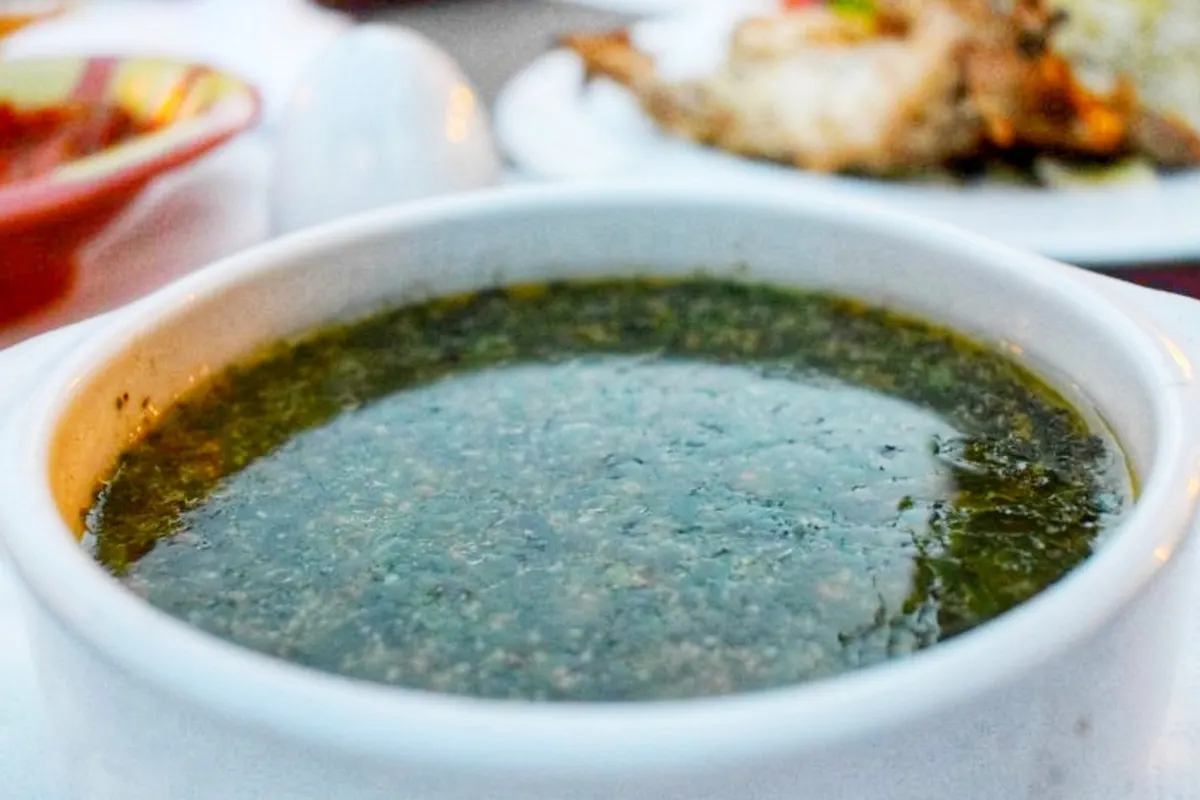
Molokhia is a soup or stew made from chopped leafy greens in an animal-based stock. The stock can be beef, chicken or seafood-based and molokhia has been eaten for years as one of the older Egyptian dishes that seems to only have ever existed there.
Fried garlic and ground roasted coriander seeds have always been traditional flavours for this green soup. The way molokhia is made will vary in different parts of Egypt, but the most basic recipe includes soaking dried leaves from a plant called “moloakh” or mallow (hence its name) overnight then cooking it with chicken broth until soft.
It’s commonly served as an accompaniment to other main dishes such as rice dishes, seafood and lamb/beef kebabs.
This dish is called mulukhiyah or mulukhiyyah and was named after the leafy greens that are the main ingredient. The plant has a slimy consistency, like okra and is a member of the jute family.
A simple dish that is high in protein, iron and various minerals. A hearty soup recipe from the Middle East.
Try this Egyptian molokhia recipe.
Koshari Egypt’s National Dish

What is the national dish of Egypt? The most recognizable and well-known dish in Egyptian cuisine is koshari, an unusual mixture of lentils, vegetables and pasta.
British colonists probably brought the ancestor of this dish with them from India. Koshari is somewhat like Indian kitchari, which means ” a mixture”. It’s not just an ordinary meal; it contains rice and lentils as well as other spices that make it uniquely delicious when mixed together in its special sauce.
Here is a recipe for the Egyptian food, koshari.
Baladi Bread, Egypt’s Flat Bread

The mouth-watering aroma of freshly made baladi bread can be smelled throughout the streets as you walk through Cairo. It’s a common and popular Egyptian food. Baladi bread can be eaten at every meal, but it’s particularly good at breakfast time when eaten fresh and warm from the bakery.
If you’re ever in Egypt, be sure to try their delicious breakfast of flatbread with cheese, tahini sauce, and eggs. This is a great way to start your day. You may also want to save some bread for lunch or dinner to eat alongside falafel, soups, or full madames.
You can make aish baladi, Egyptian bread at home with this recipe.
Shawarma, Kebab

Shawarma is a staple of Egyptian cuisine with a history dating back to the Ottoman Empire. Street vendors sell shawarmas, which are sandwiches or wraps made from grilled meat (usually beef or chicken) that has been marinated in spices for some time. The spicey meat is then roasted on a vertical rotisserie until it’s succulent enough to be rolled up into flatbread and served with salad and tahini sauce as a street food.
It can also be served as an entrée alongside salads, garlic sauce, tahini cream dressing–even fries!
Egyptian shawarma, make home-made shawarma with this recipe.
Hawawshi, Egypt’s Meat Pie

Egyptian hawawashi are a flat pocket pita or pie with a savoury meat filling. A Hawawshi street food stall in Cairo gave us our first taste of traditional hawawashi in Egypt.
Hawawashi can either be made with special hawawashi pita bread or with dough, baked in the oven complete with the spices, meat and herbs.
Sure, it was hot and dusty outside of the restaurant but what greeted me inside made up for all that. The smell coming from the ovens filled with savoury pies beckoned to us like an old friend calling our names!
We ordered one on impulse before we even knew what it was; turns out they’re sort of similar to Egyptian baked meat pies wrapped up into little packages- smaller than expected yet still filling enough after walking through those busy streets all day long!
Find an Egyptian hawawashi recipe here This recipe used bought pita pockets as a shortcut. The minced (ground) meat and spices are the secret here. Hawawashi spices include allspice, paprika, black pepper, cumin, cardamom, and cinnamon.
Egyptian Fave Beans, Ful Medammis or Ful Mudammas

Fava beans are a versatile ingredient that can be combined with garlic, lemon juice, olive oil, and cumin to create the delicious dish of fava beans, foul medammis.
Foul or ful is an Egyptian word for any type of bean or pea cooked in water until tender. It’s often served as part of mezze – small plates designed to share at social gatherings where you would also find falafel, tahini sauce and hummus among other dishes on your table.
Find a recipe for ful madames here, Egyptian style as this dish is found right around the Mediterranean.
Egyptian Moutabal
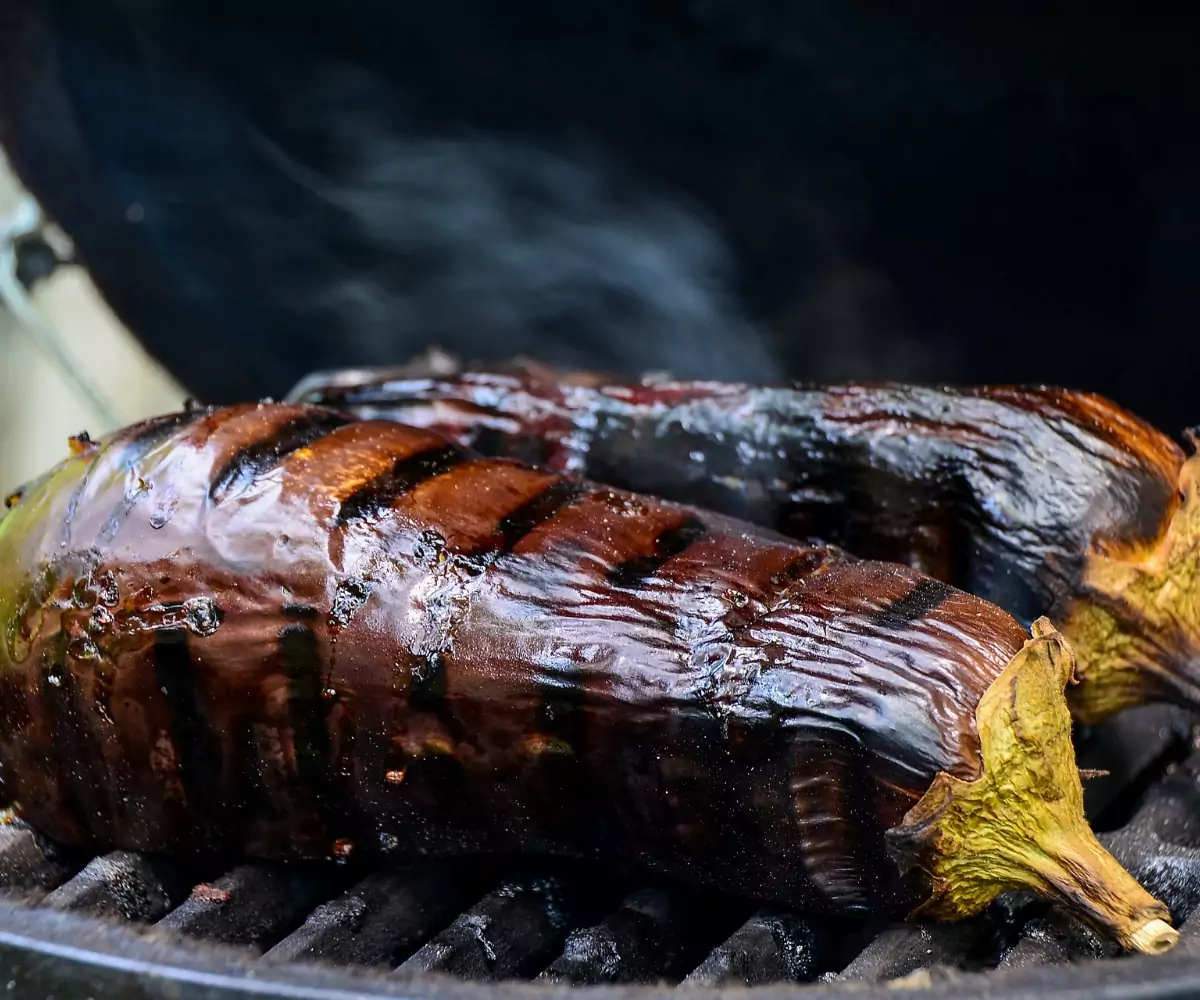
Moutabal (or moutabbal) is a Middle Eastern dish known elsewhere as baba ghanoush. Moutabal is a traditional dish that consists of roasted, charred and cooked eggplants mashed with tahini, olive oil and garlic.
Although most people wouldn’t be able to say if they were eating moutabal or baba ghanoush, there is a difference. Baba ghanoush shouldn’t contain tahini, moutabal does.
Moutabal’s humble ingredients are what make it so good. It requires just one spoonful for you to feel transported into another era where simple flavours were celebrated as they should be!
The texture will remind you how silky smooth these vegetables can get when cooked properly until tender and charred on the outside. The cooked eggplant flesh can then be milled by hand through a food mill or simply mashed with the other ingredients.
Use this moutabal recipe to make this aubergine (eggplant) appetiser at home. Moutabal is of course very similar to Melinzanasalata in Greek cuisine or the salate de vinete found in Romanian cooking.
Tahini Sauce
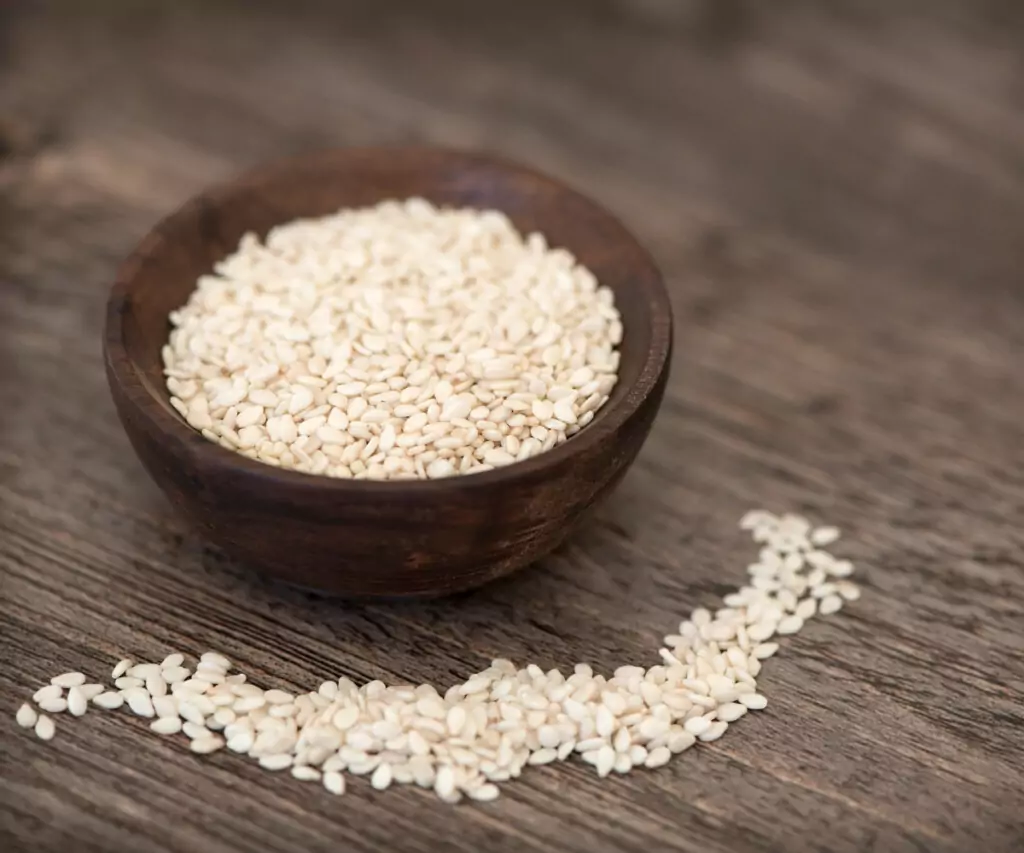
If you’re a fan of Middle Eastern cuisine, chances are that Tahini sauce is already on your radar. The thick paste made from ground sesame seeds can be found in jars in most supermarkets and makes an excellent dip for raw veggies, but is a vital ingredient in Egyptian foods.
It is also the base to many classic Middle Eastern dishes like hummus.
Tahina or tahini is a staple in Egyptian cuisine. It’s used to make many mezze, small dishes meant as appetizers but can also be served throughout the course of the meal with other courses for added variety and flavor. Tahina makes these foods taste nuttier and creamier.
It’s actually very easy to make your own tahini at home using just sesame seeds and a blender, a Vitamix blender can cope with making tahini.
To turn your tahini paste into an Egyptian tahini sauce to use with falafel, shwarma, grilled meats and fish, you will need to add vinegar, lemon or lime juice, olive oil, ground coriander and ground cumin, plus garlic and salt.
Egyptian Falafel (Taameya)

Falafel are found throughout the Middle East but they are thought to have originated in Egypt, where they are commonly made with fava beans and served with tahini sauce.
You will find falafel as a common street food in Egypt. This is a recipe for Egyptian taameya made with fava beans.
Egyptian Desserts
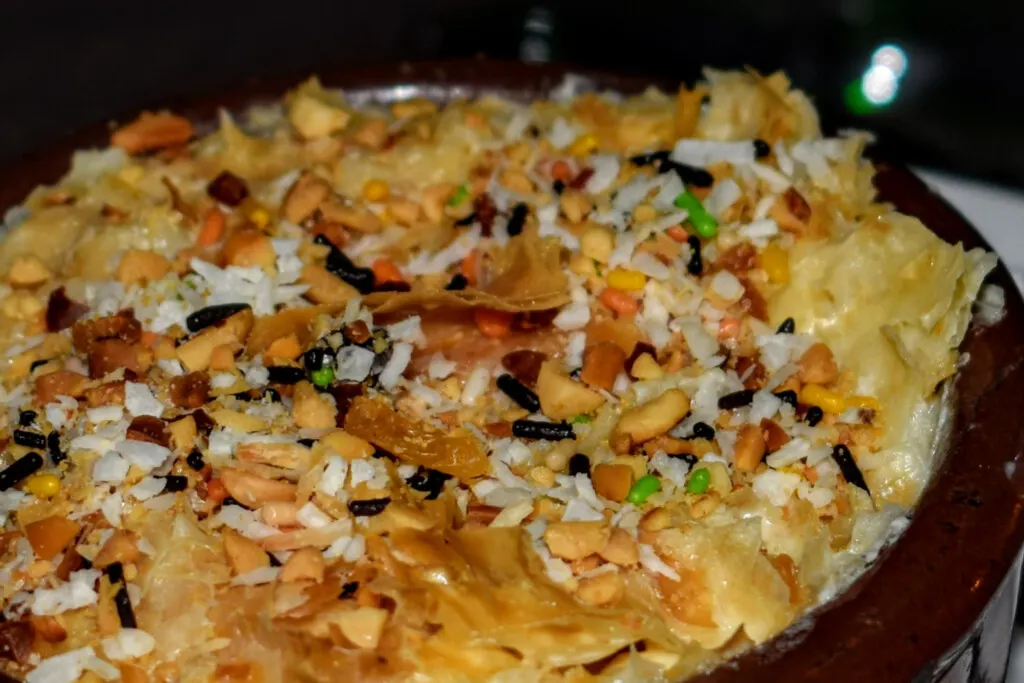
Egyptian desserts include the following super-sweet and delicious dishes.
- Halawa
- Baklava
- Maamoul cookies
- Kataifi pastry
- Kanafeh dessert (made with cheese)
- Basbousa cake (made with semolina and soaked in sugar syrup)
- Omm Ali and Um Ali (Egyptian bread pudding)
If you'd like to hire a car during your stay, use this car rental comparison tool to find the best deal!
Please check out our Pinterest account for loads of food and recipes from around the world!







